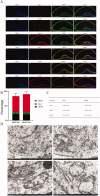Paclitaxel induces cognitive impairment via necroptosis, decreased synaptic plasticity and M1 polarisation of microglia
- PMID: 35944285
- PMCID: PMC9367659
- DOI: 10.1080/13880209.2022.2108064
Paclitaxel induces cognitive impairment via necroptosis, decreased synaptic plasticity and M1 polarisation of microglia
Abstract
Context: Paclitaxel (PTX) leads to chemotherapy brain (chemo-brain) which is characterised by cognitive impairment. It has been reported that necroptosis is associated with cognitive impairment in some neurodegenerative diseases, but it is not clear whether it is related to the development of chemo-brain.
Objective: To investigate the role of necroptosis and related changes in PTX-induced cognitive impairment.
Materials and methods: C57bl/6n mice were randomly divided into five groups: control, vehicle, and different concentrations of PTX (6, 8, 10 mg/kg). Two additional groups received pre-treatment with Gdcl3 or PBS through Intracerebroventricular (ICV) injection before PTX-treatment. Cognitive function, necroptosis, synaptic plasticity and microglia polarisation were analysed.
Results: PTX (10 mg/kg) induced significant cognitive impairment, accompanied by changes in synaptic plasticity, including decreased density of PSD95 (0.65-fold), BDNF (0.44-fold) and dendritic spines (0.57-fold). PTX induced necroptosis of 53.41% (RIP3) and 61.91% (MLKL) in hippocampal neurons, with high expression of RIP3 (1.58-fold) compared with the control group. MLKL (1.87-fold) exhibited the same trend, reaching a peak on the 14th day. The increased expression of iNOS (1.63-fold) and inflammatory factors such as TNF-α (1.85-fold) and IL-β (1.89-fold) compared to the control group suggests that M1 polarisation of microglia is involved in the process of cognitive impairment. Pre-treatment with Gdcl3 effectively reduced the number of microglia (0.50-fold), inhibited the release of TNF-α (0.73-fold) and IL-β (0.56-fold), and improved cognitive impairment.
Conclusion: We established a stable animal model of PTX-induced cognitive impairment and explored the underlying pathophysiological mechanism. These findings can guide the future treatment of chemo-brain.
Keywords: Central neurotoxicity; astrocytes; hippocampus; inflammatory factors; neuron.
Conflict of interest statement
No potential conflict of interest was reported by the author(s).
Figures






Similar articles
-
Necroptosis of hippocampal neurons in paclitaxel chemotherapy-induced cognitive impairment mediates microglial activation via TLR4/MyD88 signaling pathway.Open Med (Wars). 2025 May 2;20(1):20251182. doi: 10.1515/med-2025-1182. eCollection 2025. Open Med (Wars). 2025. PMID: 40322465 Free PMC article.
-
Resveratrol Improves Paclitaxel-Induced Cognitive Impairment in Mice by Activating SIRT1/PGC-1α Pathway to Regulate Neuronal State and Microglia Cell Polarization.Drug Des Devel Ther. 2023 Apr 12;17:1125-1138. doi: 10.2147/DDDT.S400936. eCollection 2023. Drug Des Devel Ther. 2023. PMID: 37077409 Free PMC article.
-
Spinal microglial M1 polarization contributes paclitaxel-induced neuropathic pain by triggering cells necroptosis.J Biochem Mol Toxicol. 2024 Mar;38(3):e23669. doi: 10.1002/jbt.23669. J Biochem Mol Toxicol. 2024. PMID: 38459698
-
Immune dysregulation and cognitive vulnerability in the aging brain: Interactions of microglia, IL-1β, BDNF and synaptic plasticity.Neuropharmacology. 2015 Sep;96(Pt A):11-8. doi: 10.1016/j.neuropharm.2014.12.020. Epub 2014 Dec 27. Neuropharmacology. 2015. PMID: 25549562 Free PMC article. Review.
-
Chemotherapy-induced cognitive impairment and glia: A new take on chemobrain?Toxicol Appl Pharmacol. 2024 Nov;492:117085. doi: 10.1016/j.taap.2024.117085. Epub 2024 Sep 3. Toxicol Appl Pharmacol. 2024. PMID: 39236990 Review.
Cited by
-
Nanotechnology Approaches for Prevention and Treatment of Chemotherapy-Induced Neurotoxicity, Neuropathy, and Cardiomyopathy in Breast and Ovarian Cancer Survivors.Small. 2024 Oct;20(41):e2300744. doi: 10.1002/smll.202300744. Epub 2023 Apr 14. Small. 2024. PMID: 37058079 Review.
-
Necroptosis of hippocampal neurons in paclitaxel chemotherapy-induced cognitive impairment mediates microglial activation via TLR4/MyD88 signaling pathway.Open Med (Wars). 2025 May 2;20(1):20251182. doi: 10.1515/med-2025-1182. eCollection 2025. Open Med (Wars). 2025. PMID: 40322465 Free PMC article.
-
Taming microglia: the promise of engineered microglia in treating neurological diseases.J Neuroinflammation. 2024 Jan 11;21(1):19. doi: 10.1186/s12974-024-03015-9. J Neuroinflammation. 2024. PMID: 38212785 Free PMC article. Review.
-
Potential of Natural Phenolic Compounds against Doxorubicin-Induced Chemobrain: Biological and Molecular Mechanisms Involved.Antioxidants (Basel). 2024 Apr 18;13(4):486. doi: 10.3390/antiox13040486. Antioxidants (Basel). 2024. PMID: 38671933 Free PMC article. Review.
-
Docetaxel-induced cognitive impairment in rats can be ameliorated by edaravone dexborneol: Evidence from the indicators of biological behavior and anisotropic fraction.Front Neurosci. 2023 Apr 3;17:1167425. doi: 10.3389/fnins.2023.1167425. eCollection 2023. Front Neurosci. 2023. PMID: 37077321 Free PMC article.
References
-
- Atarod D, Eskandari-Sedighi G, Pazhoohi F, Karimian S, Khajeloo M, Riazi G.. 2015. Microtubule dynamicity is more important than stability in memory formation: an in vivo study. J Mol Neurosci. 56(2):313–319. - PubMed
-
- Augusto-Oliveira M, Arrifano G, Takeda P, Lopes-Araújo A, Santos-Sacramento L, Anthony D, Verkhratsky A, Crespo-Lopez M.. 2020. Astroglia-specific contributions to the regulation of synapses, cognition and behaviour. Neurosci Biobehav Rev. 118:331–357. - PubMed
-
- Bolaños J, Almeida A, Stewart V, Peuchen S, Land J, Clark J, Heales S.. 1997. Nitric oxide-mediated mitochondrial damage in the brain: mechanisms and implications for neurodegenerative diseases. J Neurochem. 68(6):2227–2240. - PubMed
-
- Boyette-Davis J, Fuchs P.. 2009. Differential effects of paclitaxel treatment on cognitive functioning and mechanical sensitivity. Neurosci Lett. 453(3):170–174. - PubMed
-
- Finke C, Prüss H, Heine J, Reuter S, Kopp U, Wegner F, Then Bergh F, Koch S, Jansen O, Münte T, et al. . 2017. Evaluation of cognitive deficits and structural hippocampal damage in encephalitis with leucinerich, glioma-inactivated 1 antibodies. JAMA Neurol. 74:50–59. - PubMed
Publication types
MeSH terms
Substances
LinkOut - more resources
Full Text Sources
Miscellaneous
